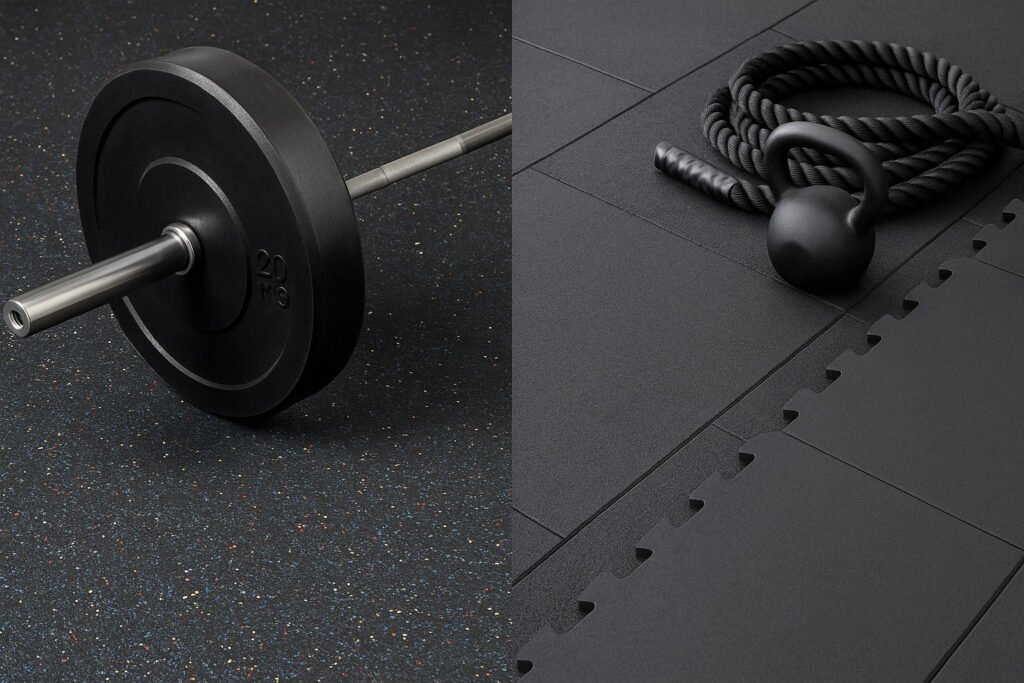Home Gym: Foam vs Rubber – Which Is Better?
Sore knees, dented floors, torn mats—bad flooring can ruin your home gym setup before you’ve even hit your stride.
Rubber flooring is more durable, safer, and better suited for high-impact workouts than foam, making it the best choice for most home gyms.

When building your home gym, the floor is often the last thing you think about—but it’s the one thing that supports every rep, jump, and drop. Many people ask me whether foam or rubber is better. I’ve tested both, supplied flooring to clients across five continents, and the answer depends on how and where you train. Let’s break it down.
Is rubber better than foam for heavy training?
Foam may feel soft at first, but it can’t take the heat—literally or physically—when the weights start dropping.
Rubber tiles or rolls are better than foam for weight training, HIIT, and any workout with equipment or impact.
Rubber flooring—especially the tiny granule rubber tile or composite rubber tile—is designed to absorb shock and protect your subfloor. Foam mats can compress or tear under barbells and dumbbells, while rubber tiles remain stable and secure. I’ve had clients replace their entire foam setup within six months, while our rubber floors last for years.
Explore our full gym rubber tile selection for home setups.
Weight Resistance Comparison
| Feature | Foam Mats | Rubber Tiles/Rolls |
|---|---|---|
| Max Weight Load | ~50–70 kg | 200+ kg |
| Surface Compression | High | Low |
| Durability | Low | Very high |
| Suitable for Weights | ❌ | ✅ Gym Rubber Tile |
Is foam more comfortable for yoga and stretching?
Soft underfoot might sound ideal—but too much squish can throw off your form and balance.
Foam mats are good for yoga and bodyweight training, but only if durability is not a priority.
Foam flooring is usually EVA or PE-based and often used in puzzle tile form. It’s lightweight, easy to move, and cushions your knees. However, it’s not anti-slip, can wear down quickly, and absorbs sweat. If your home gym is used mostly for light stretching or yoga, foam works fine. But if you’re also doing strength work, rubber rolls provide better grip, durability, and moisture resistance while still feeling comfortable underfoot.
Comfort and Control Comparison
| Feature | Foam Tiles | Rubber Rolls |
|---|---|---|
| Cushioning | High | Medium |
| Balance & Stability | Low (too soft) | High |
| Slip Resistance | Medium | High |
| Ideal Use | Yoga, Light HIIT | Mixed-use zones |
Which is easier to install in a home gym?
Laying out a floor sounds simple—until you’re trimming corners, sticking edges, or cleaning up crumbs of crumbling foam.
Foam tiles are easier to cut and reposition, but rubber tiles and rolls offer a more permanent, professional solution.
Foam mats usually connect like puzzle pieces and can be done in 15 minutes. But they shift under load and often peel at the edges. Rubber flooring is heavier and may need adhesive or tape, but once down, it stays put. We recommend interlocking puzzle rubber tiles for home users who want both stability and flexibility.
You can view real installs from clients like you on our project gallery.
Installation Comparison
| Feature | Foam Tiles | Rubber Flooring |
|---|---|---|
| Setup Time | Very fast | Moderate |
| Tools Needed | None | Utility knife, tape (optional) |
| Floor Movement | Shifts easily | Stable |
| Best for Permanent Use | ❌ | ✅ |
Which flooring lasts longer?
Buying cheap foam might feel good at first, but replacing it twice a year quickly adds up.
Rubber flooring lasts longer, handles more impact, and looks better over time than foam.
Rubber is built for commercial use. Our products are EN1177 and CE certified, meaning they meet international standards for impact resistance, durability, and safety. Foam doesn’t meet these levels of testing and breaks down under constant friction. Especially in weight zones or multipurpose garages, rubber tiles are the better investment.
Longevity & Maintenance
| Feature | Foam | Rubber |
|---|---|---|
| Lifespan | 6–12 months | 5–10 years |
| Cleaning Ease | Absorbs sweat | Easy to wipe |
| Resistance to Cuts | Low | High |
| Looks Over Time | Fades or tears | Maintains appearance |
Can I use foam or rubber outdoors or in a garage?
Humidity, dust, and UV rays can destroy foam—but rubber holds strong.
Rubber is better for garage gyms, basements, and outdoor setups thanks to its density, weather resistance, and anti-slip surface.
If your gym is exposed to temperature changes or outdoor elements, foam will warp or disintegrate. Outdoor rubber flooring or EPDM granules are better for external setups. Even in covered garages, rubber holds its form and stays grippy on dusty concrete.
Conclusion
Rubber flooring is the better choice for most home gyms—especially if you’re lifting, jumping, or using heavy equipment. Foam is okay for stretching zones, but it doesn’t match rubber in durability or stability.
Browse our full range of rubber tiles and rolls for home and commercial gyms at Lanhefloor.com
